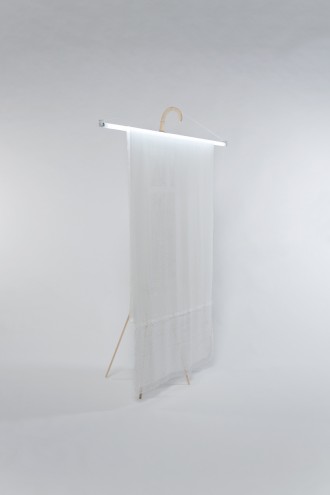Living Spaces, an exhibition tracing a hundred years of textiles in Dutch interiors, opened at the TextielMuseum on 8 February 2014.
A series of conceptual rooms present the changing use of fabrics in the household, with a starring role reserved for the museum’s extensive textile collection.
Responsible for the exhibition scenography, Studio Makkink & Bey was closely involved in the concept. The design studio was also commissioned to develop a personal vision of the interior of the future.
The rooms display interiors from seven distinctive periods: Dutch Art Nouveau, 1930s’ modernism, the post-war period, the alternative 1970s, postmodernism, recent Dutch design and finally the concept room of the future.
The central question throughout is, ‘What role does textile play in the interior?’ The interior of each space is based on the ideal image of a particular design movement or a specific trend, such as the sunken seating area of the 1970s.
In reality, many interiors are a mix of old and new. The ideal home that architects and designers envisage is one that relatively few people can afford. To illustrate this tension between ideal and reality, film fragments are shown in each room. Sometimes the fragments support the design; sometimes they sketch a contrasting image.
Against the backdrop of a comfortable middle-class living room from 1910, with furniture and textiles by well-known designers such as T.C.A. Colenbrander (1841-1930), T.W. Nieuwenhuis (1866- 1951) and Chris Lebeau (1878-1945), are images of working-class families living in poverty in dark, dank, single-room dwellings. Through news reports, music or television programmes, daily life thus seeps into the period rooms.
The interiors from different periods and social classes also reflect the complex interplay between past and present. In their furnishing choices, designers and residents make references to an earlier period, or explicitly reject it. To illustrate this, Studio Makkink & Bey chose a contemporary reference object for each period, which is placed just outside the room: a silent reflection on a period.
The museum also commissioned Studio Makkink & Bey to develop a vision of the interior of the future. In the TextielLab they produced objects inspired by flexible and nomadic living.
VouwPlaats is an ingenious knitted mattress combined with a wooden frame, which can function either as a rocking chair or a sleeping place.
VensterLicht, can be used as a flexible room divider. The pattern and material are derived from elements of silk production.
WarmteWeefsels, the dining space, was created using a clever combination of traditional and innovative techniques. The rug/tablecloth refers to old cultural traditions in the context of modern lifestyles.
The exhibition runs until 11 May 2014.










